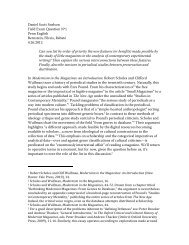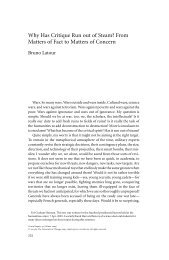The Exploit: A Theory of Networks - asounder
The Exploit: A Theory of Networks - asounder
The Exploit: A Theory of Networks - asounder
Create successful ePaper yourself
Turn your PDF publications into a flip-book with our unique Google optimized e-Paper software.
146 Edges<br />
spam while still permitting all “meaningful” e - mail to penetrate safely.<br />
And still it is a foregone conclusion that each e - mail session will require<br />
a certain amount <strong>of</strong> manual spam identification and deletion.<br />
Spam is not quite as aggressive as a computer virus or an Internet worm,<br />
and though spam attachments can be viruses or worms, spam is by<br />
and large something to be deleted or marked as trash. As an informational<br />
entity, spam is less a question <strong>of</strong> antivirus protection and more<br />
one <strong>of</strong> bureaucratic data management: algorithmic filtering <strong>of</strong> the<br />
meaningful from the meaningless, marking the corralled messages for<br />
deletion, junking attachments from mailboxes, and approving or deny -<br />
ing the status <strong>of</strong> one message over another. Spam leverages the low<br />
marginal costs <strong>of</strong> electronic mail by exploiting the flaws (some would<br />
say features) <strong>of</strong> the planetary e - mail network and in doing so elicits<br />
an antagonistic response from users in the form <strong>of</strong> informatic network<br />
management.<br />
Spam signifies nothing and yet is pure signification. Even <strong>of</strong>fline<br />
junk mail, anonymously addressed to “Current Resident,” still contains<br />
nominally coherent information, advertising a clearance sale or fastfood<br />
delivery. Spam is not anonymous, for a receiver address is a technical<br />
requirement, and yet its content has no content, the receiver<br />
address the result <strong>of</strong> algorithmic data collection and processing done<br />
by Web spiders and collected in massive databases. Often spam uses<br />
Web bugs that call back to a central server, confirming the existence<br />
<strong>of</strong> the receiver’s address, nothing more, nothing less. <strong>The</strong> spam might<br />
be deleted, but the damage is done. A subject line might advertise<br />
one thing—typically the three P’s, porn, pharmaceuticals, and payment<br />
notices—but <strong>of</strong>ten the body <strong>of</strong> the e - mail advertises something<br />
else entirely. Misspellings and grammatical errors are strategic<br />
in spam e - mails, in part to elude spam filters in an ever - escalating<br />
game <strong>of</strong> syntactic hide - and - seek. Thus Ambien becomes “Amb/ en,”<br />
or Xanax becomes “X&nax.” Many spam generators use keywords<br />
from e - mail subject headings and recombine those terms into new<br />
subject headings. But in the end, spam e - mail simply wants to generate<br />
a new edge for the graph; it wants the user to click on a URL, or<br />
to open an attachment, either action a new link in the net.<br />
In the midst <strong>of</strong> all this, something has happened that may or may<br />
not have been intentional. Spam e - mails, with their generated mis-









